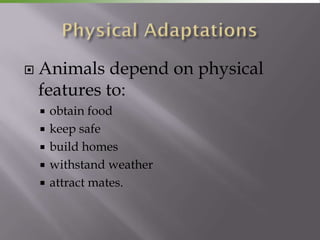
Adaptation and selective breeding
- 1. Animals depend on physical features to: obtain food keep safe build homes withstand weather attract mates.
- 2. Do not develop during an animal's life but over many generations. Examples: shape of a bird's beak number of fingers color of the fur thickness or thinness of fur shape of the nose or ears
- 3. Defensive adaptations include: Predator avoidance Hiding and camouflage Group defense Fleeing Signal Warnings
- 4. Many organisms avoid predators by the use of cryptic coloration. A requirement of camouflage in many cases is that the individual choose an appropriate background.
- 5. The adjustment or changes in behavior, physical features, and structure of an organism to become more suited to an environment.
- 6. Natural selection requires on three things: 1. Organisms produce more offspring than can survive. 2. Individuals vary in their characteristics. 3. Many characteristics are inherited by offspring from their parents.
- 7. • Some individuals will be better suited to their environment They will survive and reproduce more successfully than individuals without those characteristics. • Future generations: contain more genes from better-suited individuals. • Result: characteristics will evolve over time to resemble those of the better-suited ancestors.
- 8. • The process where only the organisms best adapted to their environment tend to survive. • These survivors transmit their genetic characteristics in their offspring to new generations. • Those less adapted, without the right genetic characteristics tend to be eliminated.
- 11. Two Kinds: White speckled moth Black moth In early 1800’s dark form was very rare. Dark form caused by dominant mutation that occurs spontaneously.
- 12. Peppered moths rest on trees and depend on camouflage for protection.
- 13. Unpolluted Areas: trees are covered in lichens and the light form of the moth is hard to see. In mid 1800’s air pollution in British cities covered trees with soot. In cities dark form became common and light form rare.
- 15. Inmid 1950’s pollution controls were introduced in Britain and frequency of the black moth form has declined since then.
- 17. http://www2.d125.org/~nfischer/Moth/defa ult.htm Complete the sheet to accompany the simulation